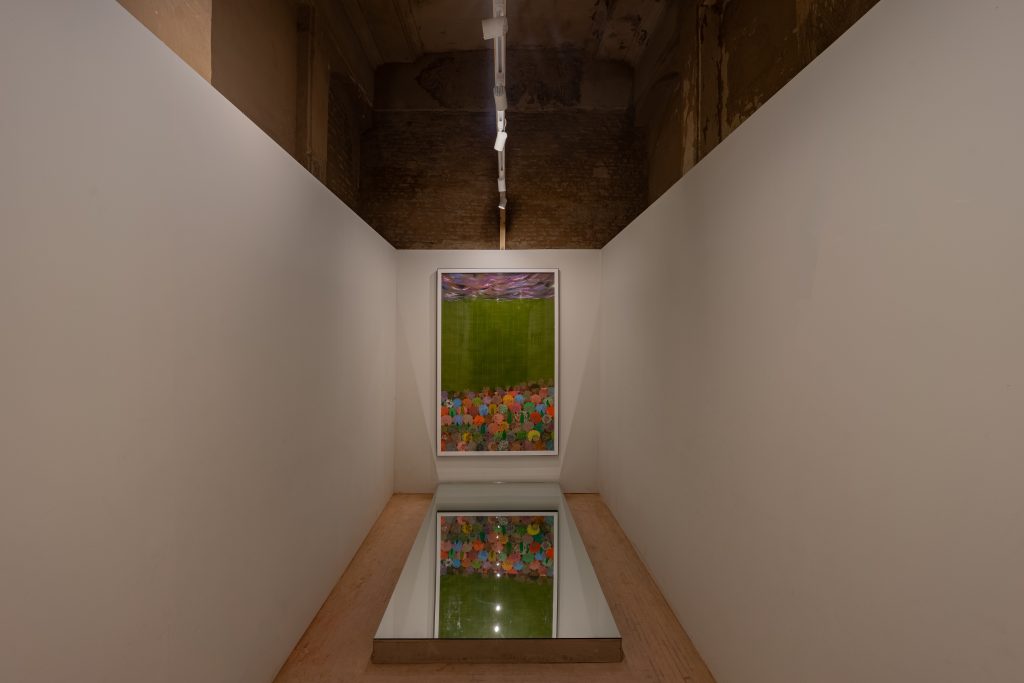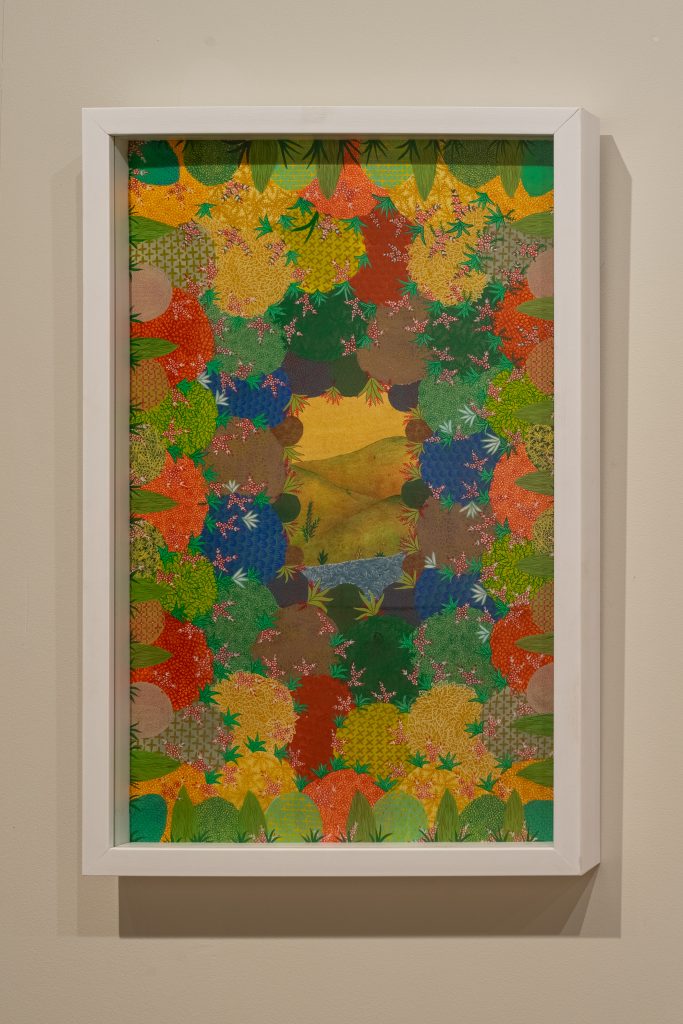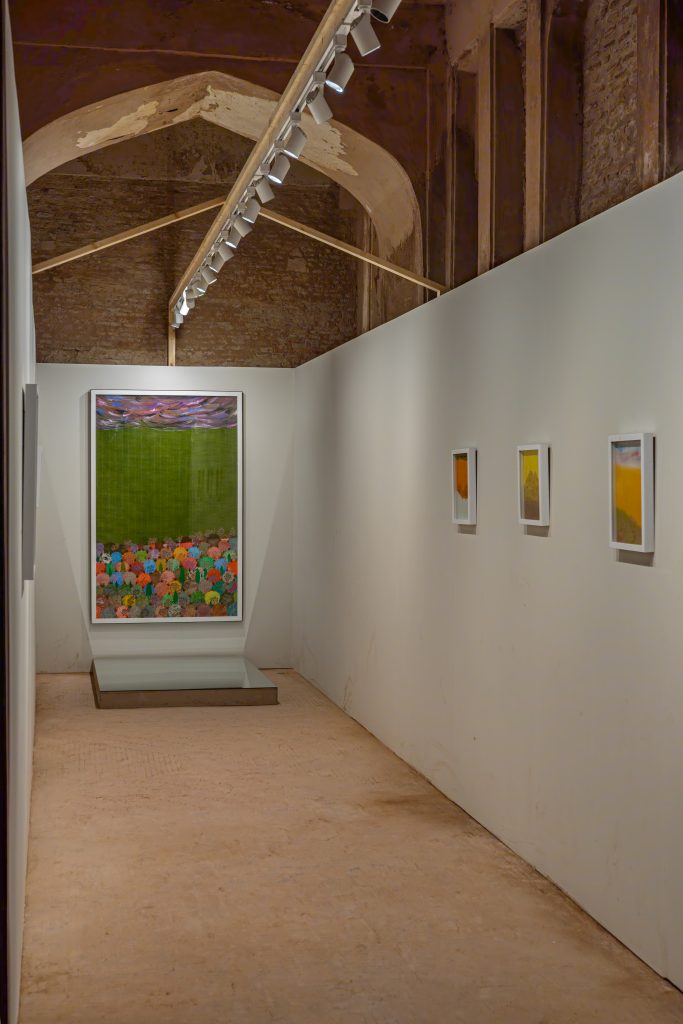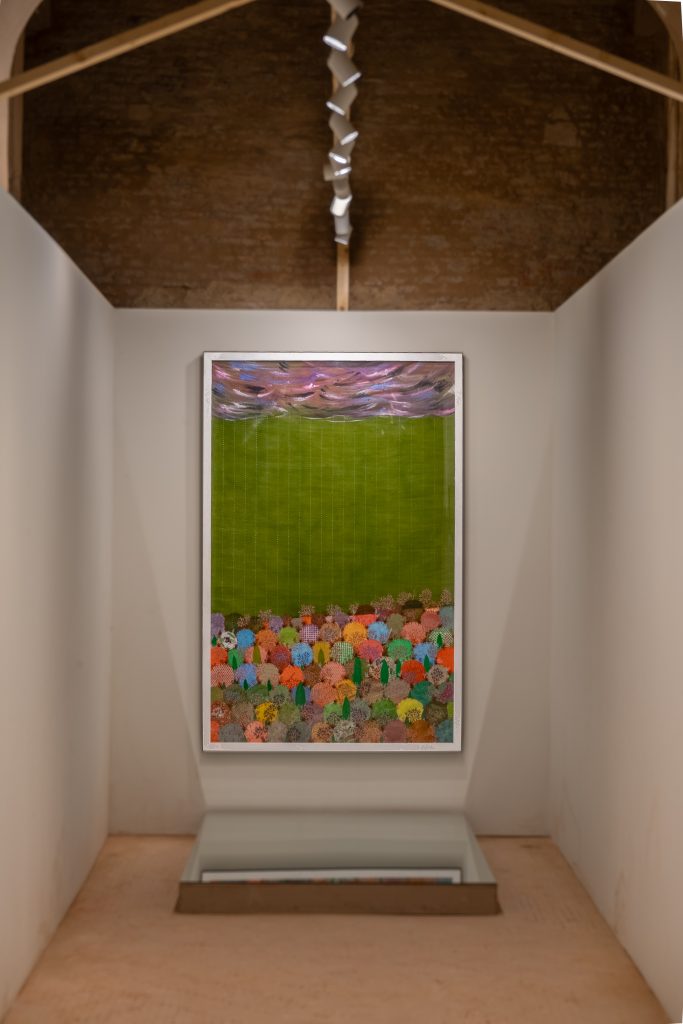Feroza Hakeem
Khorshid Fruit, 2023
Gouache and Irani ink on Arches paper
70.25” x 44.5”
In addition to Khorshid Fruit (2023) and the five paintings of My City (2024), Hakeem also contributed to Elyas Alavi’s Sound of Silence, nearby in Akbari Mahal.
Khorshid Fruit translates to mixed fruit in Persian, and represents the diverse crowd Hakeem has encountered after moving to Lahore, which makes her feel safe as a minority. In the painting, the artist created trees by collaging newspaper-cut texts with words like “unsafe,” “targeted,” “Quetta,” “Afghanistan,” and “poor” to reflect the narratives of how Hazara people are perceived publicly. Nonetheless, colorful plants grow vibrantly out of this negativity, signaling the restorative power of the earth against human biases and cultural essentialism. Using nature as a metaphor for social relations and identity formation, Hakeem skilfully appropriates the visual language of miniature painting traditionally used by the ruling Mughals and Persians to express the plight of the long-oppressed and displaced Hazaras.
My City (2024)
My City 1, 2024 My City 2, 2024
Gouache on wasli Gouache and ink on wasli
20.7” x 13.2” 13.3” x 10.3”
My City 3, 2024 My City 4, 2024
Gouache and Gouache on wasli
ink on wasli 11” x 9.7”
12.3” x 10.1”
My City 5, 2024
Gouache on wasli
9” x 15.2”
In the five paintings of My City (2024), Hakeem allows her grief as a member of the Hazara community, with first hand experience of oppression, to transform her surroundings into strange landscapes, a homeland of wild extremes. Beneath rugged mountains dominating a horizon bathed in snowy dust, trees and saplings grow in seemingly barren land. They suggest resilience and hope, and also connect with the nature symbolism from Persian tradition, in which the graceful apricot represents woman, and the steely cedar man.
Feroza Hakeem (b. 1995, Quetta) graduated from the National College of Arts in 2019 with a major in miniature painting. In 2018, she studied for one semester at the Siena Art Institute, Italy. Her work was exhibited in Belt and Road in Suzhou University Museum, China, and is part of the collection at BUITEMS University, Red Cross Center, Hazara Artist Forum. In 2021, she participated in the online Experimenter Learning Program led by Bani Abidi and Priya Sen alongside artists from South Asia and Europe. Hakeem was the first grantee of the artist residency program in Art Saraye in 2022.
فیروزہ حکیم
خورشید فروٹ، 2023
آرچز پیپر پر آبی رنگوں اور ایرانی سیاہی کے ساتھ نقاشی
70.25” x 44.5”
فیروزہ حکیم نے خورشید فروٹ (2023) اور میرا شہر (2024) کی پانچ پینٹنگز کے علاوہ ایلیاس ایلاوی کے ساؤنڈ آف سائلنس جو اکبری محل میں بھی دکھایا گیا، میں بھی کردارادا کیا ہے۔
خورشید فروٹ فارسی میں ملے جلے پھل کا ترجمہ ہے اور اس سے مراد وہ متنوع ہجوم ہے جس سے فیروزہ لاہور منتقل ہونے کے بعد ملی، اور جس نے انہیں ایک اقلیت کے طور پر تحفظ کا احساس دلایا۔ اس پینٹنگ میں، فنکارہ نے درختوں کو اخبار کی تراشیدہ تحریروں سے بنایا ہے، جن پر “ہسپتال”، “غیر محفوظ”، “ہزارہ”، “ہدف”، “کوئٹہ”، “افغانستان” اور “غریب” جیسے الفاظ لکھے گئے ہیں تاکہ اس بات کی عکاسی کی جا سکے کہ ہزارہ لوگوں کو عوامی طور پر کس طرح دیکھا جاتا ہے۔ پھر بھی، اس منفی رجحان سے رنگ برنگے پودے پھوٹتے ہیں جوانسانی تعصبات اور ثقافتی دقیانوسیت کے مقابلے میں زمین کی شفا بخش قوت کو ظاہر کرتے ہیں۔ فیروزہ قدرت کو سماجی تعلقات اور شناخت کی تشکیل کے استعارے کے طور پر استعمال کرتے ہوئے، منی ایچر پینٹنگ کی بصری زبان کو اسی مہارت سے اپناتی ہیں جو روایتی طور پر مغل اور فارسی حکمرانوں نے استعمال کی تھی، تاکہ طویل عرصے سے کچلے ہوئے اور بے دخل ہزارہ لوگوں کی حالت زار کو بیان کیا جاسکے۔
فیروزہ حکیم
میرا شہر 1، 2024
وسلی کاغذ پر آبی رنگ کی نقاشی
20.7” x 13.2”
میرا شہر 2، 2024
وسلی کاغذ پر آبی رنگ اور سیاہی کی نقاشی
13.3” x 10.3”
میرا شہر 3، 2024
وسلی کاغذ پر آبی رنگ کی نقاشی
12.3” x 10.1”
میرا شہر 4، 2024
وسلی کاغذ پر آبی رنگ کی نقاشی
11” x 9.7”
میرا شہر 5، 2024
وسلی کاغذ پر آبی رنگ کی نقاشی
9” x 15.2”
میرا شہر (2024) پانچ پینٹنگز میں حکیم ہزارہ کمیونٹی سے تعلق رکھنے کی وجہ سے ظلم کا ذاتی تجربہ کی بدولت اپنے غم کو اپنے ارد گرد کے ان عجیب و غریب مناظر میں تبدیل کرتی ہے جس میں ایک ایسا وطن دکھایا جاتا ہے جو انتہائی شدتوں سے بھرا ہوا ہے۔ ان کے کاموں میں، برفانی گرد میں ڈوبی ہوئی افق پر حاوی سخت پہاڑوں کے نیچے، درخت اور پودے بے حد دلیری سے بڑھتے ہیں، حالانکہ مٹی بظاہر غیر مہمان نواز نظر آتی ہے۔ فیروزہ کی پینٹنگز میں نظر آنے والی مزاحمت اور امید دراصل قدرت سے ہی ماخوذ ہیں، کیونکہ فارسی روایت میں خوبصورت خوبانی ایک عورت کی نمائندگی کرتی ہے اور مضبوط دیودار ایک محافظ مرد کی علامت ہے۔
فیروزہ حکیم( پیدائش 1995، کوئٹہ) نے 2019 میں نیشنل کالج آف آرٹس سے منی ایچر پینٹنگ میں گریجوایشن کیا۔ 2018 میں انہوں نے سیینا آرٹ انسٹیٹیوٹ، اٹلی میں ایک سمسٹر کے لیے تعلیم حاصل کی۔ ان کے کام کی نمائش بیلٹ اینڈ روڈ، سوزو یونیورسٹی میوزیم، چین میں ہوئی، اور وہ بی یو آئی ٹی ای ایم ایس یونیورسٹی، ریڈ کراس سینٹر اور ہزارہ آرٹسٹ فورم کے کلیکشن کا حصہ ہیں۔ 2021 میں، انہوں نے جنوبی ایشیا اور یورپ کے فنکاروں کے ساتھ بانی عبیدی اور پریا سین کی جانب سے منعقدہ آن لائن ایکسپیریمنٹر لرننگ پروگرام میں حصہ لیا۔ فیروزہ 2022 میں آرٹ سرائے کے آرٹسٹ ریزیڈنسی پروگرام کی پہلی گرانٹی تھیں۔






